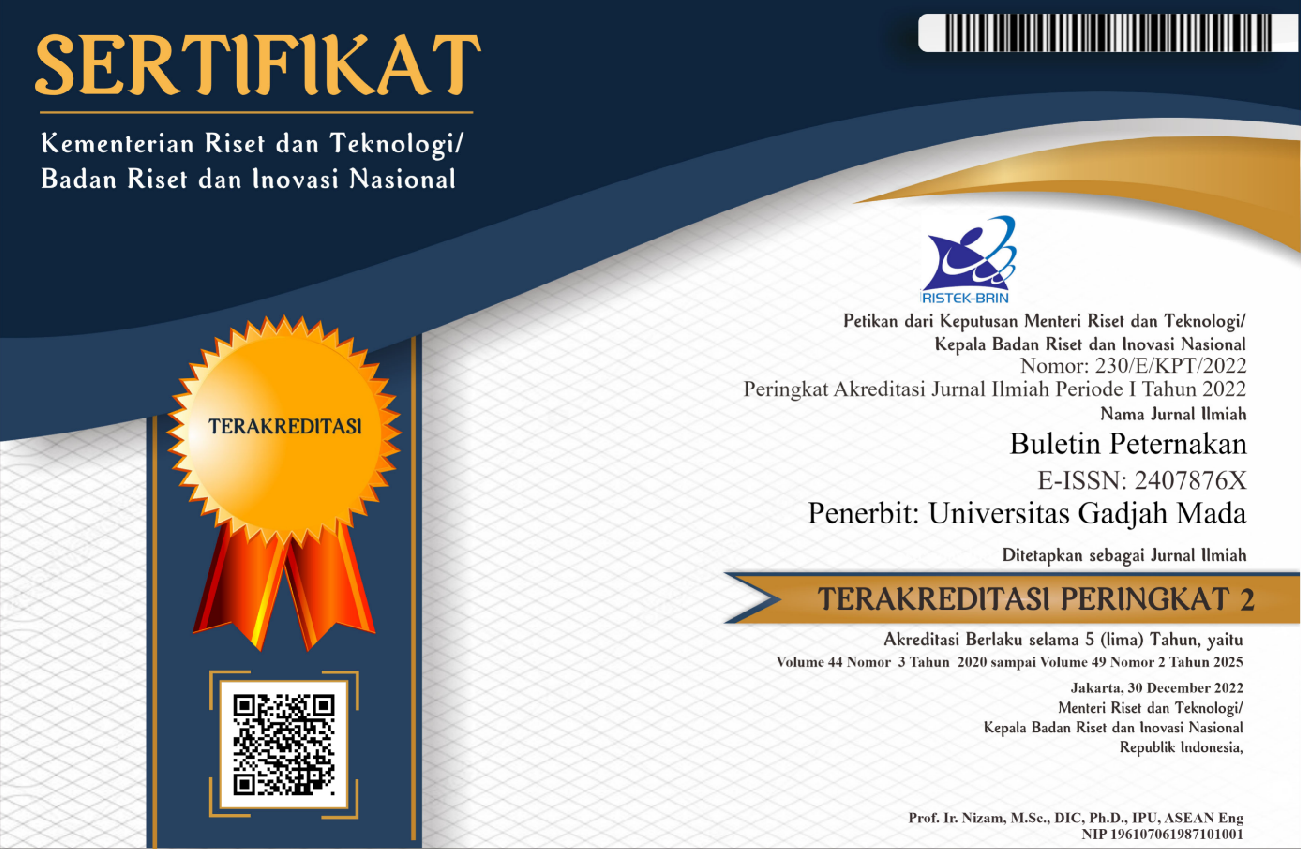Effect of Cashew Nutshell Oil Supplementation as Phenol Source for Protein Protection on In Vitro Nutrient Digestibility
Rahma Fitriastuti(1*), Lies Mira Yusiati(2), Budi Prasetyo Widyobroto(3), Zaenal Bachruddin(4), Chusnul Hanim(5)
(1) Faculty of Animal Science, Universitas Gadjah Mada, Yogyakarta, 55281, Indonesia
(2) Faculty of Animal Science, Universitas Gadjah Mada, Yogyakarta, 55281, Indonesia
(3) Faculty of Animal Science, Universitas Gadjah Mada, Yogyakarta, 55281, Indonesia
(4) Faculty of Animal Science, Universitas Gadjah Mada, Yogyakarta, 55281, Indonesia
(5) Faculty of Animal Science, Universitas Gadjah Mada, Yogyakarta, 55281, Indonesia
(*) Corresponding Author
Abstract
The current study was aimed to evaluate the ability of phenol content in cashew nutshell liquid (CNSL) in binding protein and its effect on in vitro nutrient digestibility. This research divided into three steps, there were determination of total phenol and tannins content in CNSL, optimalization binding of CNSL tannin to bovine serum albumin with the determination of protein-percipitable phenolics compound and protein content using Lowry method, after that amount of optimalization supplementation of CNSL was used for measuring on in vitro nutrient digestibility by Tilley and Terry method. The results showed that phenol and tannin content of CNSL were 148.69 g/100 ml and 28.3 g/100 ml. One gram tannin in CNSL could be bound by 65.83 g protein. Optimum tannin were used in this study was 5.85 g tannin or equivalent to 163.91 mg of CNSL. Amount of CNSL were used in various levels, there are 0, 50, 100, 150 dan 200 mg. CNSL supplementation reduced dry matter, organic matter crude protein digestibility in rumen, and didn’t reduce dry matter dan crude protein in vitro post rumen digestibility. Supplementation of CNSL increased feed efficiency on in vitro.
Keywords
Full Text:
PDFReferences
Beauchemin, K. A., S. M. McGinn, T. F. Martinez and T. A. McAllister. 2007. Use of condensed tannin extract from quebracho trees to reduce methane emissions from cattle. J. Anim. Sci. 85: 1990-1996.
Coutinho, D.A.,A. F. Branco, G. T. Santos, M. P. Osmari, A. L. Teodoro, and T. G. Diaz. 2014. Intake, digestibility of nutrients, Milk production and composition in dairy cows fed on diets containing cashew nutshell liquid. Acta Sci. Anim. Sci. 36: 311-316.
El-Waziry, A. M., M.E.A. Nasser and S.M.A. Sallam. 2005. Processing Methods of Soybean Meal: 1-Effect of roasting and tannic acid treated-soybean meal on gas production and rumen fermentation in vitro. J. Appl. Sci. Res.1(3): 313-320.
Fratianni, F., M. Tucci, M. De Palma, R. Pepe, and F. Nazzaro. 2007. Polyphenolic composition in different parts of some cultivars of globe artichoke (Cynara cardunculus L. var. scolymus (L.) Fiori). Food Chem. 104: 1282-1286.
Frutos, P., G. Hervás, F. J. Giráldez and A. R. Mantecón. 2004. Review. Tannins and ruminant nutrition. Spanish Journal of Agricultural Research 2:191-202.
Jayanegara, A., E. Wina, C.R. Soliva, S. Marquardta, M. Kreuzera, and F. Leibera. 2011. Dependence of forage quality and methanogenic potential of tropical plants on their phenolic fractions as determined by principal component analysis. Anim. Feed. Tech. 163:231-243.
Hart, K. J., D.R. Ya´nez-Ruiz, S.M. Duval, N.R. McEwan, and C.J. Newbold. 2008. Plant extracts to manipulate rumen fermentation. Anim. Feed Sci. Tech. 147: 8-35.
Makkar, H. P. S. 2000. Quantification of Tannins in Tree Foliage. FAO/IAEA Working Document, Vienna.
Naumann, H. D., L. O. Tedeschi, W. E. Zeller and N. F. Huntley. 2017. Invited Review: The role of condensed tannins in ruminant animal production: advances, limitations and future directions. R. Bras. Zootec. 46: 929-949.
Nelson, D. L. dan M. M. Cox. 2004. Lehninger Principles of Biochemistry Fourth Edition. Chapter Amino Acids, Peptides and Proteins.W. H. Freeman & Company.
Ozdal, T., E. Capanoglu and F. Altay. 2013. A review on protein-phenolic interactions and associated changes. Food Research Intl. 51: 954-970.
Shinkai, T., O. Enishi, M. Mitsumori, K. Higuchi, Y. Kobayashi, A. Takenaka. K. Nagashima, M. Mochizuki, and Y. Kobayashi. 2012. Mitigation of methane production from cattle by feeding cashew nutshell liquid. J. Dairy Sci. 95:5308-5316.
Santos, A., T. J. A. Dos, B. Q. Araújo, A. M. das G. L. Citó, J. da Silva, J. Saffi, M. F. Richter, and A. de B. F. Ferraz. 2011. Antioxidant properties and chemical composition of technical Cashew Nutshell Liquid (tCNSL). Food Chem. 126: 1044-1048.
Santos-Buelga, C., and V. de Freitas. 2009. Influence of fenolics on wine organoleptic properties. In: Wine Industry and Biochemistry. Springer New York. pp 529-570.
Sasongko, W. T., L. M. Yusiati, Z. Bachruddin, and Mugiono. 2010. Optimalisasi pengikatan tanin daun nangka dengan protein bovine serum albumin. Buletin peternakan 34(3): 154-158.
Silanikove, N., A. Perevolotsky and F. D. Provenza. 2001. Use of tannin-binding chemicals to assay for tannins and their negative post ingestive effects in ruminants. Anim. Feed Sci. Tech. 91:69-81.
Tilley, J. M. A. and R. A. Terry. 1963. A two-stage technique for the in vitro digestion of forage crops. J. Brit. Grassland Soc.18:104-11.
Trevisan, M. T. S., B. Pfundstein, B. Haubner, R. Würtele, G. Spiegelhalder, B. Bartsch, and R. W. Owen. 2006. Characterization of alkyl phenols in cashew (Anacardium occidentale) products and assay of their antioxidant capacity. Chem. Food Toxicol. 44:188-197.
Watanabe, Y., R. Suzuki, S. Koike, K. Nagashima, M. Mochizuki, R. J. Forster, and Y. Kobayashi. 2010. In vitro evaluation of cashew nutshell liquid as a methane-inhibiting and propionate-enhancing agent for ruminants. J. Dairy Sci. 93:5258-5267.
Article Metrics
Refbacks
- There are currently no refbacks.

This work is licensed under a Creative Commons Attribution-ShareAlike 4.0 International License.
Buletin Peternakan (Bulletin of Animal Science) Indexed by:

This work is licensed under a Creative Commons Attribution-ShareAlike 4.0 International License.









